Do you like catchy blog titles like these?
- What 10 Studies Say About The Best Times To Post On Social Media
- How To Attract An Audience With The Best Blog Photography Tips (+128 Free Images)
- 21+ Easy Ways To Build An Email List That Will Skyrocket By 552% In 1 Year
- The 10-Minute, 10-Step Solution For The Best Blog Outline
Data and psychology say you do, and your audience will, too, when you apply this method to your own blog posts. Would you like to learn how to write catchy blog titles like that?
If you’re genuinely interested in writing better, catchier, and awesome-r blog titles for your already great content, you’re in the right place. This post is going to help you maximize the time you invest in writing your awesome content to help you get more social media shares and traffic from your blog titles.
You’re going to learn how to use the four pillars of awesome content in your blog titles, how to use psychology to increase shares and clicks, and how to use the best words to capture your audience’s unique interest. To top it off, you’ll even get a ton of proven catchy blog title templates, formulas, and structures we’ve seen work for getting more social shares and traffic.
Let’s do this thing.
P.S. Want to test our advice? Make sure every headline is optimized with Headline Analyzer Studio; the data-driven software from CoSchedule that will help you write a great headline every time.
Three Resources to Write Catchier Blog Titles
Start writing better headlines now, with these three downloads:
- A Catchy Blog Titles Infographic that breaks down the elements of strong blog headlines.
- A Blog Title Performance Tracking Template to help you A/B test blog titles when shared on social media.
- A Content Calendar Excel Template to store your headline ideas and plan every blog post you write.
Bonus: Catchy Blog Title Generator
Step 1: Write Catchy Blog Titles With Four Pillars of Successful Content
A very basic principle in content marketing is to look back at your best content and repeat its success. I’ve recently taken this idea to the next level at CoSchedule to help us use our data from past content to help us plan better content and actually predict future growth.
That analysis revealed that top-performing content reflects four key traits extremely well. On the other hand, worst-performing content does poorly in all four areas.
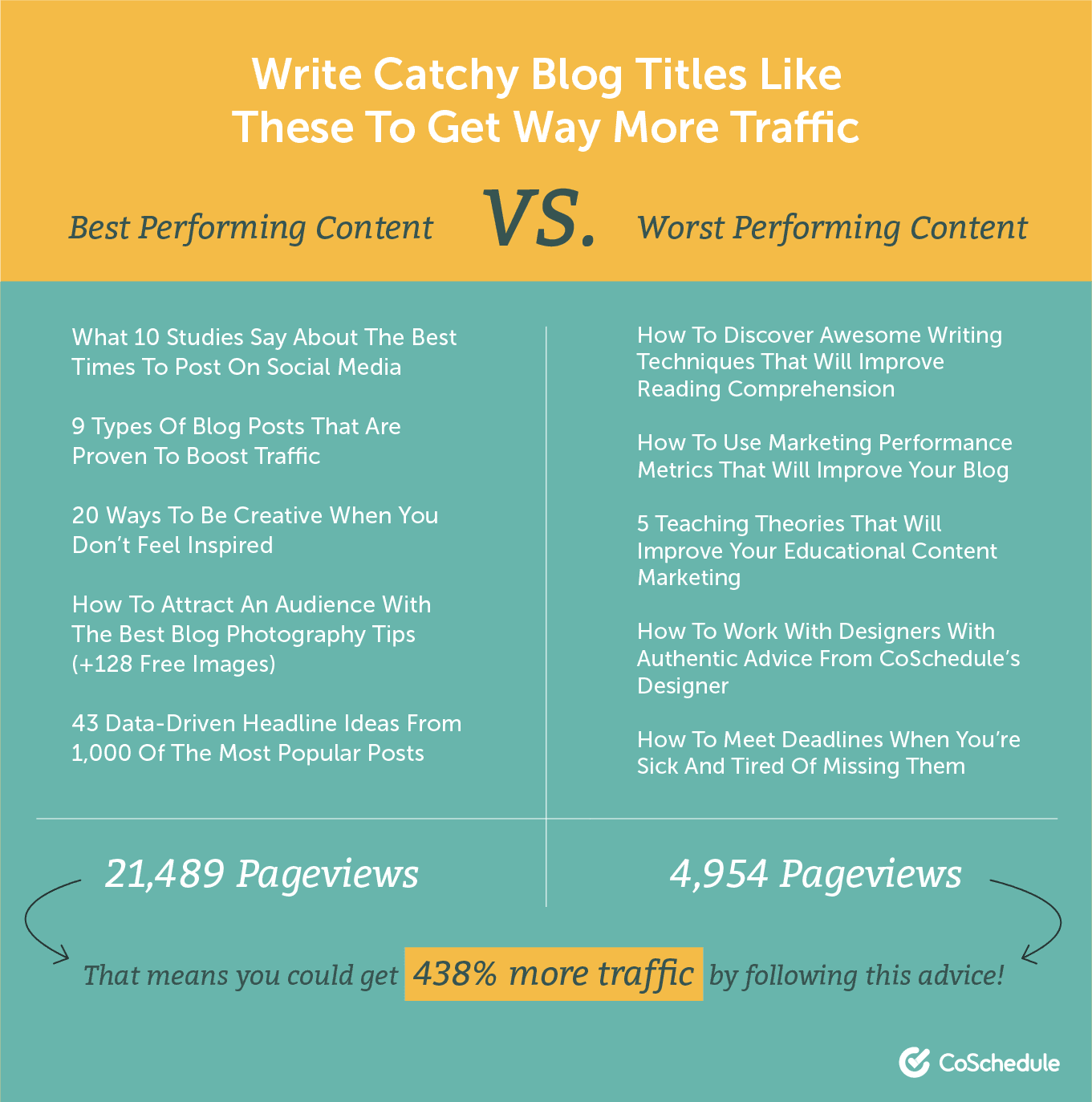
Simply rank each blog post according to four questions, giving each question a 1–3 ranking — meaning a top post according to your gut would be a 1 whereas the worst would be a 3.
- Was this a topic your readers would be deeply interested in learning more about?
- Was this post deeply researched to share unique and better information than any other source on the Internet?
- Did the post turn the research into actionable, exhaustive, how-to advice?
- Was the keyword well-chosen and optimized throughout the post to help you experience long-term traffic?
After you rank them, compare each blog post’s score to its page views to translate your gut into actual data. The results should show that most of your high-scoring content ends up being your best-performing blog posts. If not, you just learned a lot about how your gut is off, and you can use your new knowledge backed by data to strategically choose to publish better content.
You can do this process for your content, too. The point is: since the idea of solid topic, research, depth, and keywords define success for content, your blog titles should reflect those qualities to connect with your audience from the moment they see your headlines.
Share the Value
The #1 thing that will help you write successful blog titles is by first creating content your audience will be deeply interested in learning more about. It makes sense, right? That’s why this post kinda started off with that tangent, but it’s coming full circle right now:
- Use the words that describe the topic in your blog title. Avoid ambiguity.
- Ask yourself the question, “If I were a member of my audience, would I read this blog post instead of any others like it? Why?” Then, like a little kid, go down the why rabbit hole to get to the core value you’re providing to your readers.
- Just like you would with marketing a product, define the value proposition for your blog posts and include that in your blog titles.
From there, define the single best value proposition for your content.
For example, after a ton of brainstorming, this blog post’s value proposition is to increase traffic. Recent research shows 29% of content marketers measure success primarily through social media and 38% see traffic as their #1 form of measurement. This blog post helps both of those groups of content marketers reach their goals.
Pro Tip: Write your blog title before you write your blog post. This practice will help you define the value proposition so you can connect it into the blog post, which guarantees your blog title will deliver on its promise.
Use Numbers and Facts to Get 206% More Traffic
See what I did there?
The second pillar of successful content is to back up the claims you made in your value proposition with research. This is where you prove to your audience that your blog post is different because it’s actually based on real success they could also experience if they just read your blog post.
Informal research from Canva and Ian Cleary of Razor Social suggests that including numbers in your blog titles can double your social shares. Data from Brian Dean at Backlinko also suggests that including numbers in your blog titles can increase your clickthrough rate by 36%!
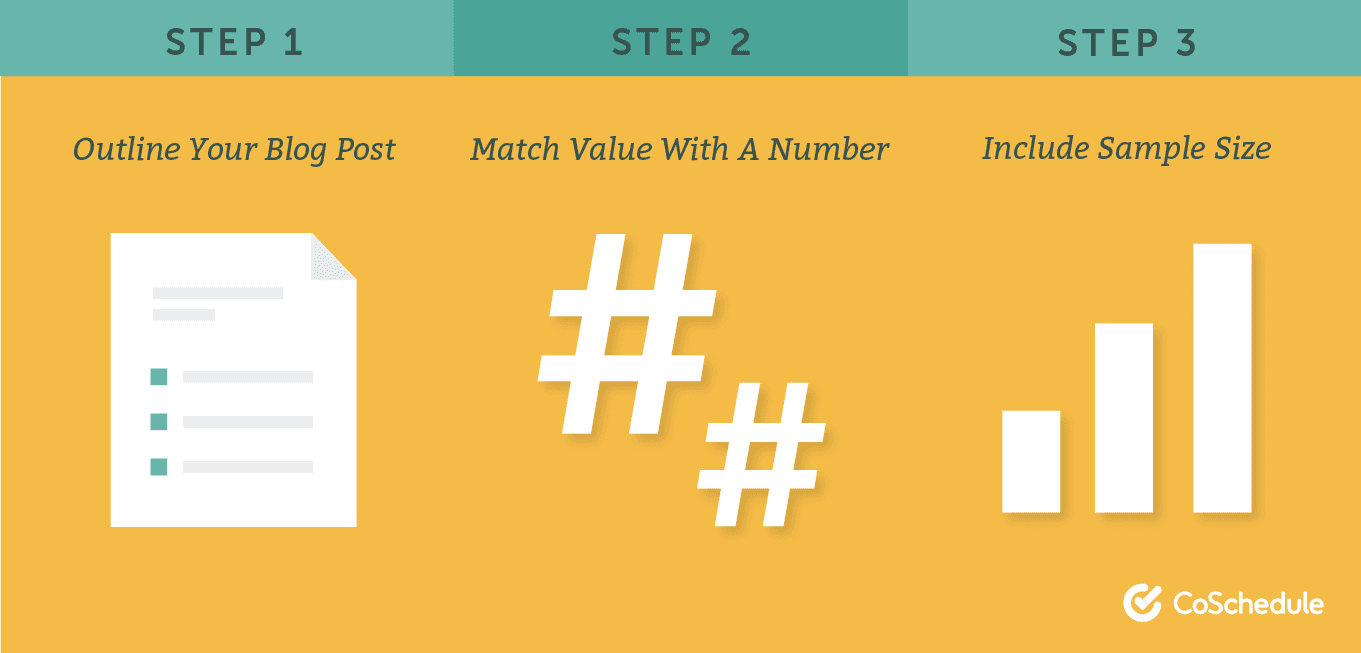
There are a few ways to do this:
- Outline your blog post in the form of a list. Use the number of points from your list in your headline.
- Put a real number to your value proposition. If your value proposition is to save time, your number could be save 30 minutes of time. If your value proposition is to generate more sales, your number could generate 32% more sales.
- Share the sample size of your data to increase your credibility. For example, if your post is about managing multiple projects at once and you sourced tips from 100 industry experts, include that number in your blog title.
You get the picture.
The blog post you’re reading right now has several numbers; I chose to focus on 500 words, 100 templates, and the results you could achieve if you follow this advice with 438% more traffic. We drew those 500 words from more than 1 million of the most-shared headlines we’ve seen go through CoSchedule, so I could have also included that number.
Pro Tip: If you have multiple numbers to increase your credibility and your audience’s perception of success, write several headlines with multiple numbers. Then A/B test them to eventually choose the best one and change your blog title even after your post publishes. That will give you more initial shares and click-throughs and will boost your long-term traffic to that blog post.
This is not blowing smoke. Seven of our top 10 posts on the CoSchedule blog have at least one number in the blog title, if not more. Of those seven, six are in the top six positions and they get on average 206% more traffic than an average blog post.
Tell the Story and Deliver
The third pillar of awesome sauce content is depth and delivering on the promises you made in your blog title with your value proposition and research.
When you translate this to your blog title, it means telling the story truthfully and as clearly as you can. If your blog post doesn’t follow through on the value proposition, or you can’t back up your number, you’re doing it wrong.
This is where you translate your actionable, in-depth, how-to advice into a few words that help your readers understand what to expect after clicking through to read your content:
- Critically analyze the words you use to make sure you deliver on your promise. For example, if you use the word template in your blog title, your audience will likely expect a free download of some kind. Make sure your blog post delivers on that promise.
- Consider searcher intent when you write your blog titles. Ask yourself, “As a user, what would I expect to read if I clicked through on this blog title?” Critique the way you include numbers to make sure you deliver on the promise.
It seems obvious, but it’s incredible how often blog titles don’t deliver on the promises they make.
I wanted to include examples of successful blog titles outside the marketing industry to complement this post. Unfortunately, I was super dismayed by the sheer lack of quality behind the headlines I found because they were purely clickbait.
Here are some things to watch:
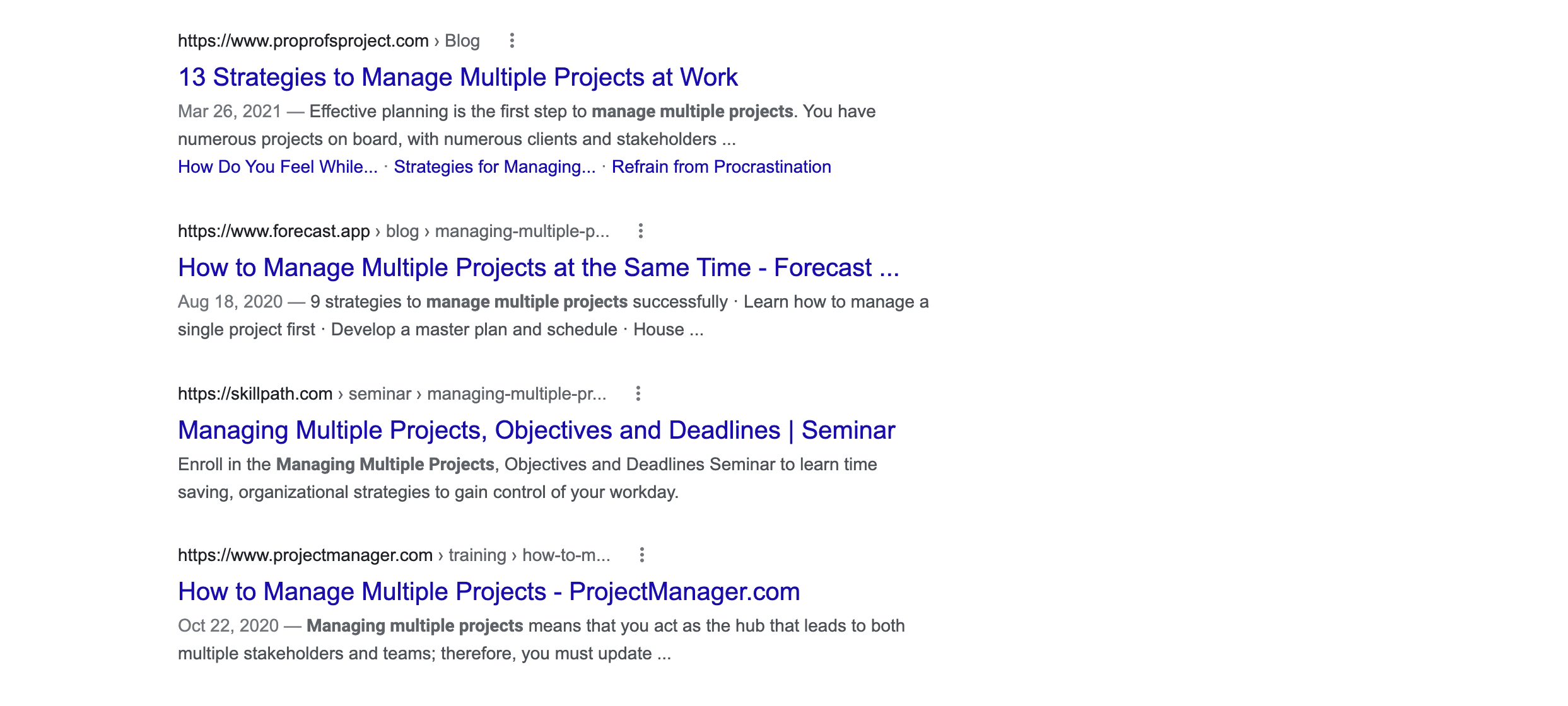
The top five search results promised how to resolve my challenge to manage multiple projects at once, but they barely scratched the surface. You can avoid situations like these for yourself by thinking of searcher intent. As a searcher, they may:
- Want to know how to manage multiple projects at once.
- Need detailed information on processes, so a step-by-step procedure would be great.
- Not care about your blog’s word count goals, but rather getting all of the information I need to do my job better.
If you were to click-through the top five search results for this example, most of the blog posts don’t deliver on these three searcher stories — to use a term from agile project management. In fact, #2 only delivers one mistake instead of the five it promises while all of the others neglect the how to nature they promise.
That causes poor reader experience that could increase your bounce rate and cause you to lose fans, like my friend John here who commented on a recent post Ben wrote:

Good blog titles are only as good as the actionable, in-depth, and how-to advice that follows after the clickthrough.
Takeaway: Write blog titles that tell the complete story in your posts, and deliver on the promise you make. If you’re not sure if you’re making this mistake, take a look at your bounce rate in Google Analytics. If it’s more than 5%, you can use the advice from this post to help you work through even better blog titles.
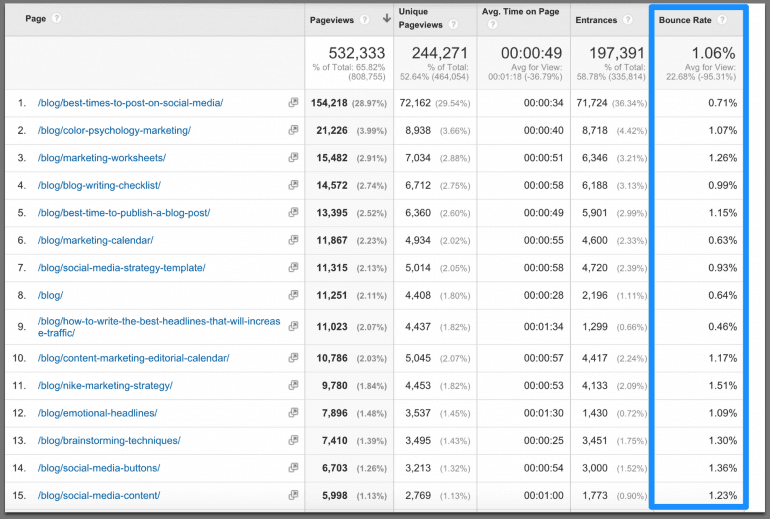
Use the Keyword in Your Blog Title
The fourth pillar of great content is optimizing it for your audience to find it via search engines. The 17% of you who put 5–10 hours into writing blog posts can get more traffic from your content if you simply optimize it so people can find it when they need it.
I say it that way because Google seems to reward longer content with better rankings. If time is an indicator of length, depth, covering everything having to do with that topic and giving actionable stories, then those who spend more time creating content have more opportunity to get traffic and social shares from this pillar of successful blog posts.
Relating that back to your blog titles, Brian Dean recently researched the top 200 ranking factors that make Google tick, and one of them was this:
H1 tags are a “second title tag” that sends another relevancy signal to Google.
What Brian is trying to say, is that when you target a keyword in your blog posts, it makes sense to include that keyword in your blog titles for your page title and H1. Brian also notes that including the keyword closer to the beginning of your blog title (specifically in your page title) helps search engines understand the importance of it in relation to your post.
Step 2: Use Psychological Triggers in Your Blog Titles to Encourage More Social Shares
Jonah Berger is the author of Contagious: Why Things Catch On, and found there are six STEPPS behind the psychology of contagious content:
- Social currency: People talk about things to make them look good.
- Triggers: Topics that are at the top of your mind are at the tip of your tongue.
- Emotion: When you care about something, you share it.
- Public: When you see people doing something, you’ll imitate it.
- Practical value: You share things to help others.
- Stories: You like to share things that are wrapped in narratives.
I’ll let Jonah himself explain his research a little more thoroughly:
Neil Patel also researched a few different studies to find five key elements that help influence social shares:
- Curiosity
- Amazement
- Interest
- Astonishment
- Uncertainty
When the New York Times analyzed why their readers were sharing content, they found people share:
- Valuable and entertaining content to change opinions or encourage action.
- Content that helps define who they are and what they care about.
- Information that helps them stay in touch with people and maintain relationships.
- Content that helps them feel involved in the world.
- Content that supports causes or brands they care about.
Recommended: Good Title Generator
Now, all of this goes way beyond writing catchy blog titles, and it’s all great advice you can use to craft even better content. Let’s take all of this research and apply it to your blog titles specifically:
Appeal to Your Audience’s Emotional Need for Resolution
Appeal to the emotional reasons people would read your content. Understanding your readers’ challenges and suggesting your blog post offers a solution immediately from your headline will encourage clicks and shares.
For example, think of headlines including “that will” messaging in them: 21+ Easy Ways To _____ That Will Skyrocket Your Followers By 552% In one Year.
Focus on Remarkableness
Take advantage of trendy words and appeal to entertainment, amazement, and astonishment. Jonah uses the word remarkable often to describe content that gets shared, so include noteworthy information in your blog titles that shows the remarkable information your readers will get after they click.
For example, Neil Patel offers this example for a blog title that amazes: How Spending $162,301.42 on Clothes Made Me $692,500. That blog title also has numbers as proof that you can experience the same success as Neil if you just follow his advice.
Make Your Audience Feel Like Rockstars Among Their Peers
Write your blog titles to help people look good. Your readers want to feel successful, engaged in the world, and be supportive. Your readers feel as though the blog titles from the content they share — like yours — define who they are as people.
A great way to connect this emotion to your blog titles is through uncertainty. When someone reads your blog post, they know the answer to something others don’t, so let them boast their knowledge while also encouraging more clicks back to your content.
Do this by asking questions. And not just any questions. Close-ended questions that essentially cause your readers to answer with yes or no. In a recent case study, I found that social messages with close-ended questions get more clickthroughs than any other type of social message we shared. In fact, close-ended questions get 255% more clickthroughs than open-ended questions!
For example, write a blog title like: Are You Using _____ To Get 277% More _____? Blog titles like this suggest that the sharer knows the answer and is getting the kind of success your headline promises. It also makes anyone seeing that blog title feel the fear of missing out (FOMO) that will encourage them to click through just to know the answer — and hey, you might get the snowball effect of yet another share.
Provide a Practical Way to Solve a Problem
Blog titles that focus on practical value are those that offer how-to, actionable, and oftentimes step-by-step solutions to problems. They cover information that is interesting — not the same-old thing that feels like it’s been done over and over again.
You can do this by differentiating your blog titles by including your value proposition in them directly.
For example, this blog title includes the value proposition of doing something super quickly (because who has time these days) coupled with a promise of doing it in 10 quick steps: The 10-Minute, 10-Step Solution For The Best _____.
Step 3: Use Catchy Words That Are Proven to Increase Action
Other than focusing on telling a complete story with your blog title and connecting it to your audience’s emotional needs, what specific words make certain blog titles catchier than others?
Do You Use the Words Your Audience Uses?
That’s a good question and one that Joanna Wiebe from Copy Hackers has an answer.
Joanna is a copywriting genius. When I read her Headlines, Subheadlines, and Value Propositions book recently, one very interesting point really stuck with me — among tons of others; you should totally check out her book since you’re interested in writing better blog titles:
Use the words your audience uses in your blog titles.
That’s a very simple idea, and it’s one that can help you connect with your audience immediately because it’s exactly how they think.
While planning a headline test with Crazy Egg’s website, Joanna surveyed their users by asking them to describe Crazy Egg in two to three words. From there, she worked the most-used words into her headlines to connect with an audience like Crazy Egg’s existing users. That. Is. Brilliant.
When we launched a new course recently, I took Joanna’s advice and used the words from our audience’s biggest challenges in the headline to connect with their lingo immediately:
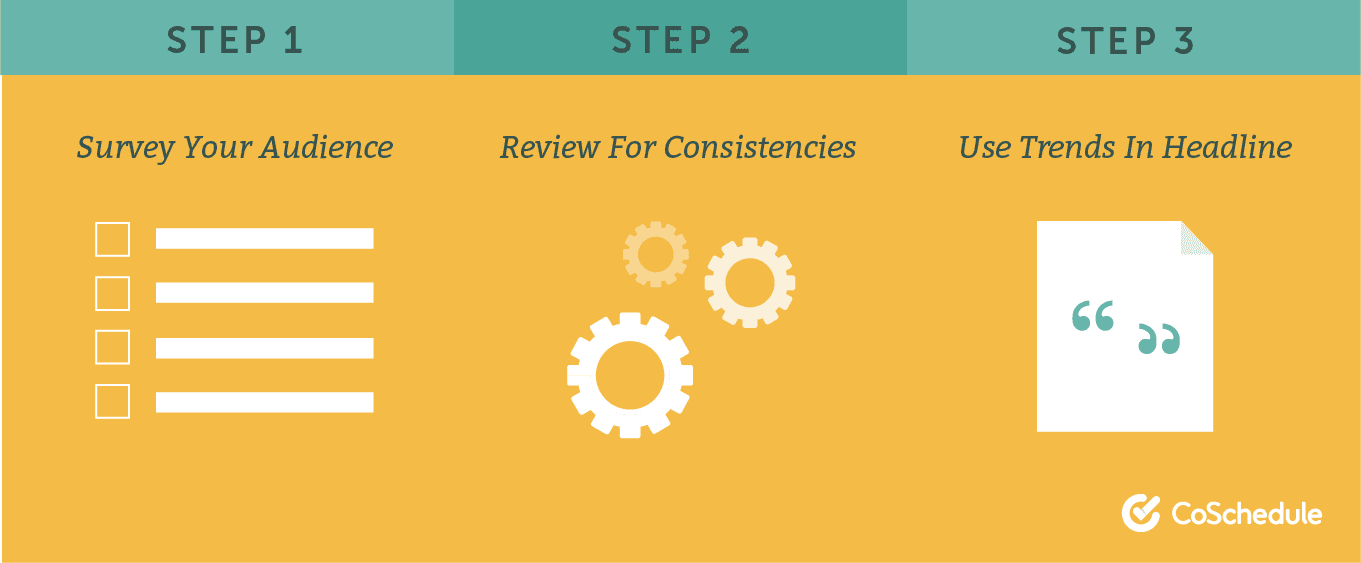
The words were: on track, organized, and save time. The result? For an initial launch just to our existing email subscribers, 2,181 people signed up with page view to signup conversion rate of 27%!
You can apply that same strategy to the words you use in your blog titles by sending a simple survey to your existing email subscribers. Just promise them a reward, a free e-book or exclusive content of some kind is perfect for this, that it’ll only take two minutes, and ask one simple question: “What is your biggest professional challenge as a (insert job title here)?”
That will not only give you tons of blog post ideas; you’ll also have their own words you can use in all of your copy and blog titles moving forward.
Use Words Proven to Increase Your Social Media Shares
Since CoSchedule is a social media editorial calendar tool, we have access to millions of blog titles. Literally. Being the data nerds we are, we looked at more than one million headlines and found the words used most often in the top shared content.
From there, we compiled a list for you of those 500 words to use as a tear sheet for inspiration the next time you’re writing blog titles:

Pro Tip: Use these words with headline studio to increase your grade and score as you write your blog titles.
Step 4: Rock These Catchy Blog Title Templates to Jumpstart Your Creativity
You could take all the advice from this post and start writing catchy blog titles right now, since you know the background of your four pillars of successful content, how to connect to your audience emotionally, and how to use catchy words in your headlines.
You could also get a little more advice from the headline pros out there with some formulas so you don’t have to come up with everything from scratch.
Sound good?
Let’s take a look at the best blog title templates from around the Interwebs.
Write better headlines with formulas from Joanna Wiebe of Copy Hackers: Joanna wrote an amazing post with every copywriting formula you could imagine. In it, she says she keeps a swipe file handy for when she sees cool headlines she’d like to use for inspiration later on. Might be something for you to consider, too. :)
Write magnetic headlines with templates from Brian Clark of Copyblogger: Brian is a genius when it comes to writing pretty much anything. He has some great advice for using social proof, insider knowledge, and appealing to ease to get more traffic.
Get attention with headline templates from Michael Hyatt: Michael is afriend of CoSchedule who’s built a platform of 615,597 fans to date. His blog titles definitely tie into the information throughout this post, and his blog templates, though simple, are extremely effective at getting more readers.
Increase conversions with headline examples from Steve Hogan on the Crazy Egg blog: 41 Engaging Examples of the Best Headlines to Rally Your Audience. Since Crazy Egg — a tool that helps people get better conversions — thought this information was awesome, I thought you gals and guys would enjoy it, too.
Get more social shares with a little advice from CoSchedule users: We recently analyzed the 4,302,684 blog titles in our database, focusing on the headline structure behind the 1,000 most popular posts that got the most social shares of any content we’ve ever seen. Those formulas are proven to increase your chances of getting more social shares from your blog titles.

To top off that list, I’d also like to share the blog title structures from our top-performing content on the CoSchedule blog:
- What {#} Studies Say About {Subject}
- {#} {Noun} That Are Proven To {Desirable Outcome}
- {#} Ways To Be {Adjective} When You Don’t {Verb} {Adjective}
- How To {Verb} An {Audience} With The Best {Subject} Tips (+{#} Free {Resources})
- {#} Data-Driven {Noun} From {#} Of The Most Popular {Noun}
- {#}+ Easy Ways To {Verb A {Noun} That Will Skyrocket By {#}% In 1 Year
- How To Use {Noun} To Increase Your {Desirable Outcome}
- The {#}-Minute, {#}-Step Solution For The Best {Noun}
- How To Rock A {Noun} That Will Save You Tons Of Time
- How To {Verb} Your {Noun} For Massive Growth
If you start with these ten blog title formulas and write ’em in headline studio.
I can nearly guarantee you’ll get an awesome grade and score which means you’ll get more social shares for your hard work.
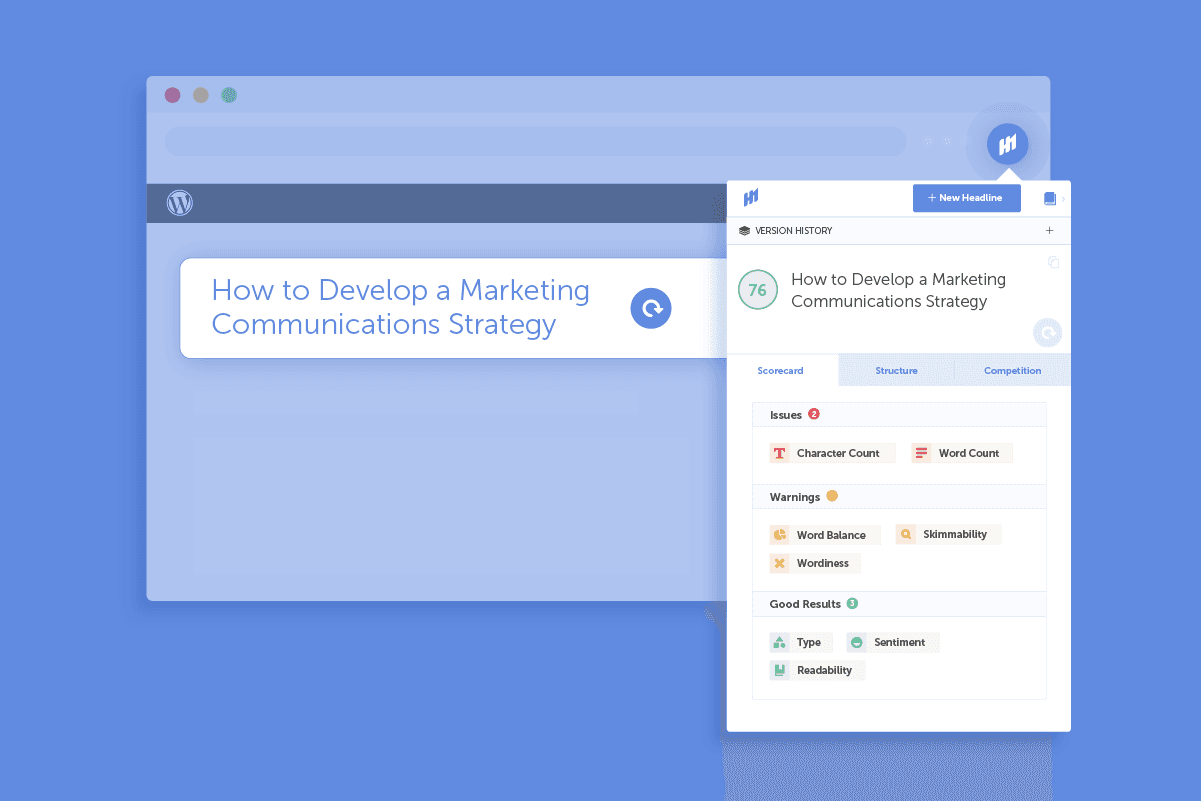
Which brings me to the last step here…
Step 5: Use Five Blog Title Tools to Take Your Headlines to the Next Level
Woohoo! You made it and understand the best ways to write super catchy blog titles. Let’s just say you’re having a bit of trouble staying inspired. There are some great tools out there to help you out:
Impact has a blog title generator that helps you insert a topic you’d like to write about and spits out all sorts of headlines to get the inspiration going.
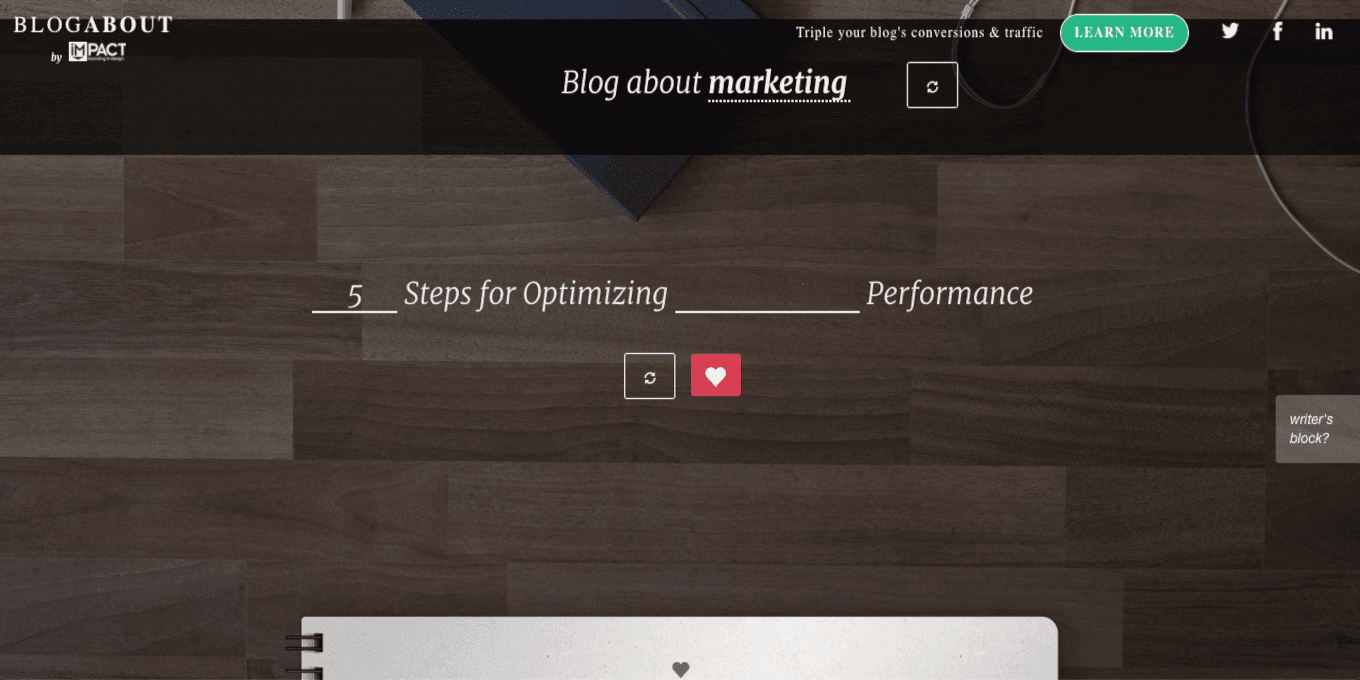
Similarly, HubSpot has a blog topic generator that will help you enter in a couple nouns that you might use in your blog post (think about using the keyword), and generate a bunch of topics based on your nouns.
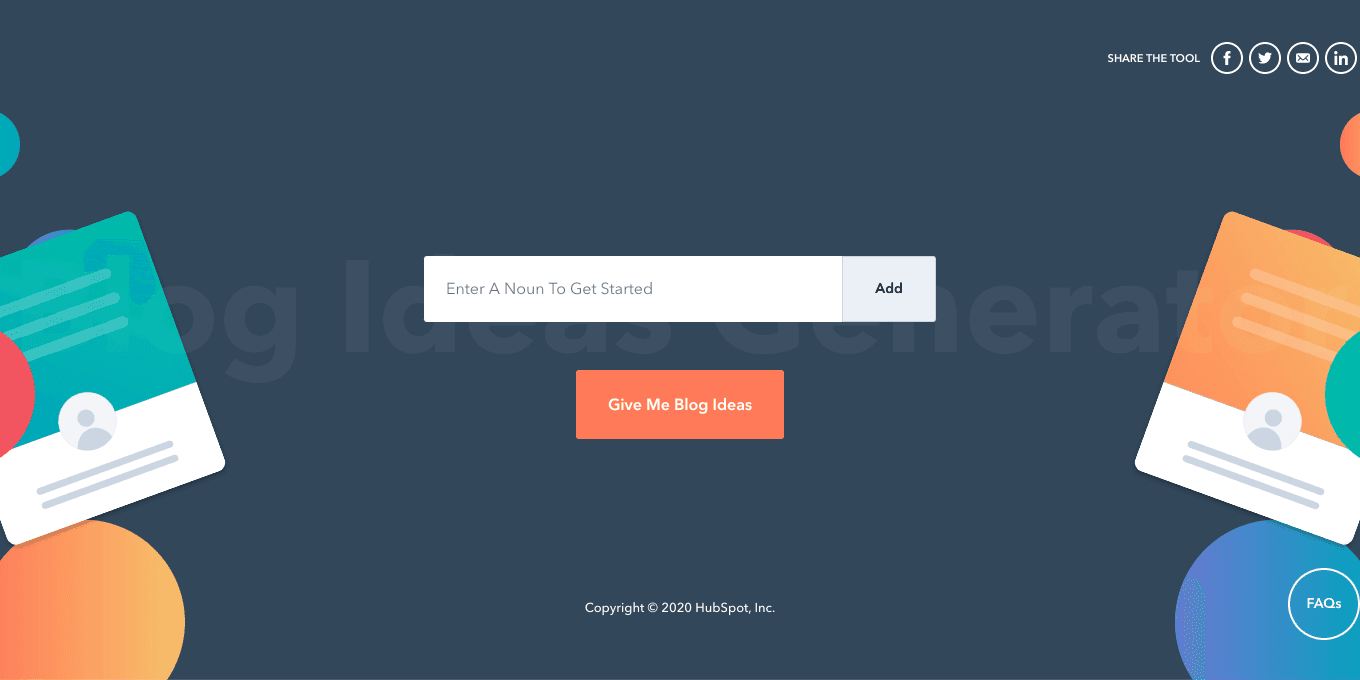
Where HubSpot starts,SEOPressor takes it a step further and literally asks you to enter a keyword into their blog title generator to get the ideas flowing.
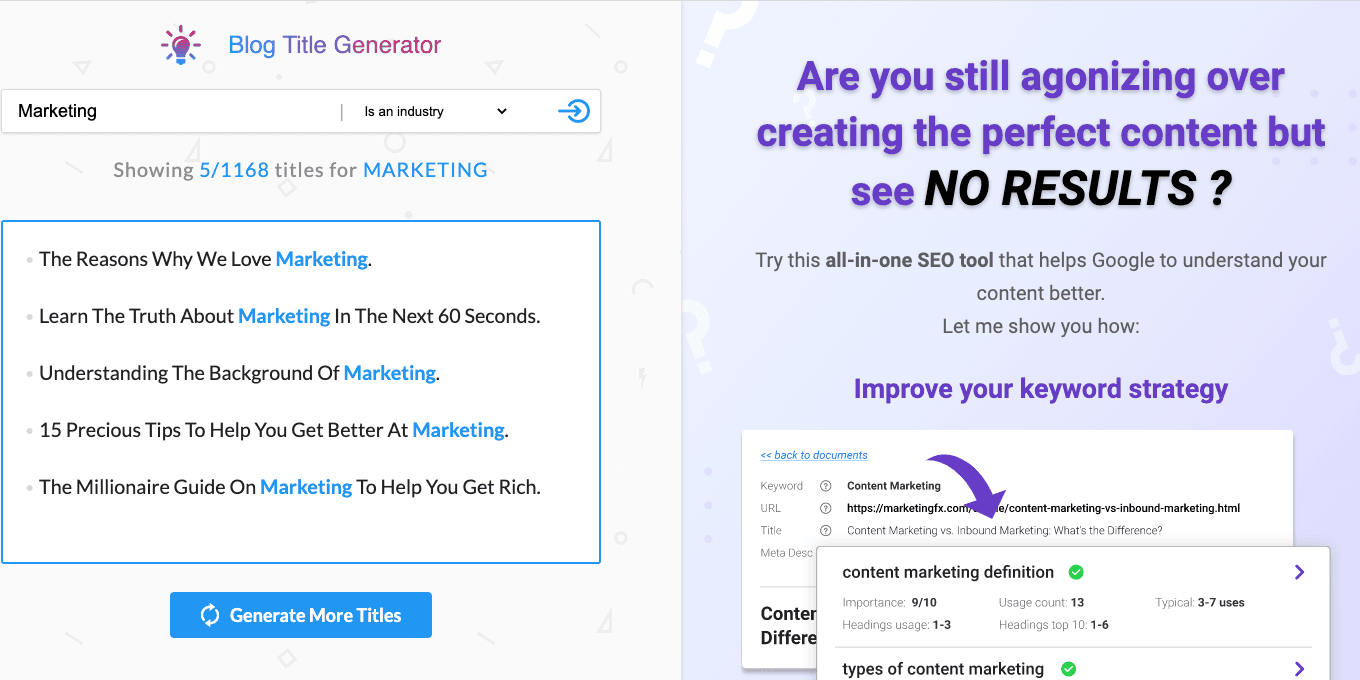
And if you’re looking for something a little more humorous and trendy, the content idea generator by Portent is the one for you.
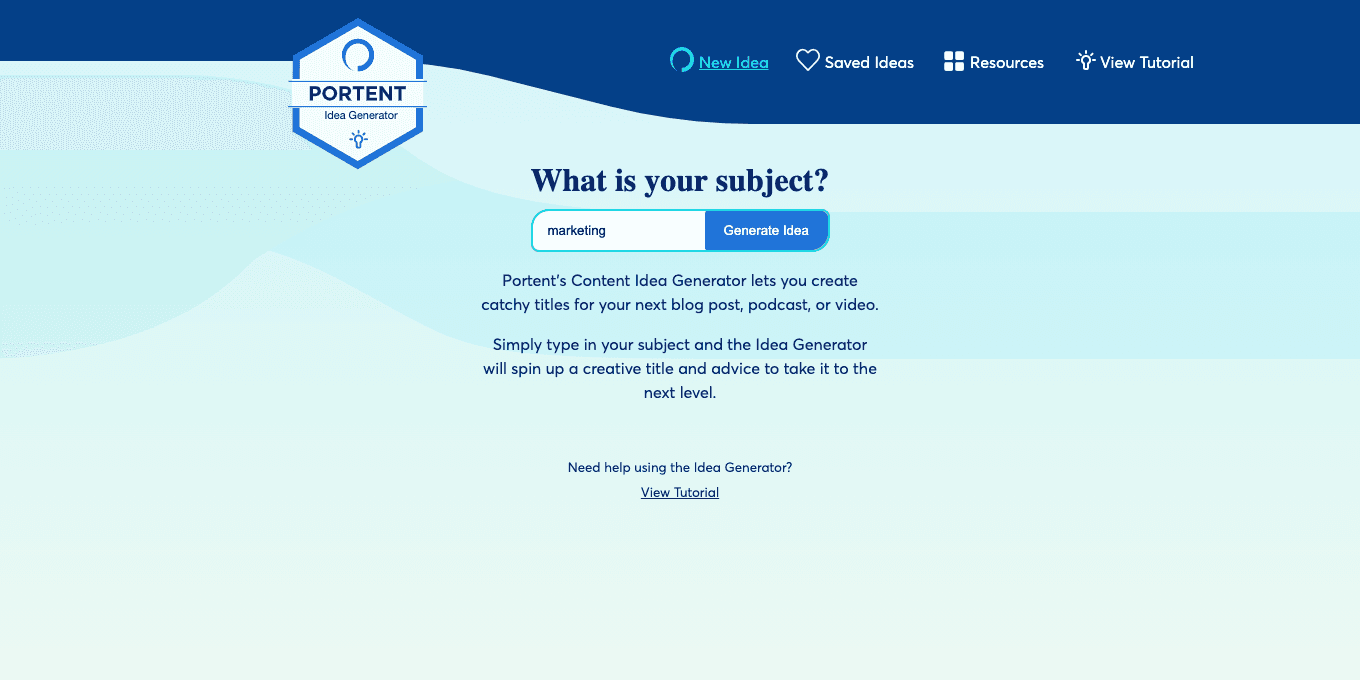
Last but not least, once you come up with your headline through any of these generators, run it through Headline Analyzer Studio, which is now built directly into your CoSchedule editorial calendar. While your blog title might be close, you could probably use a few of the lessons you’ve learned from this post — along with the huge list of emotional words — to improve your blog title even further to increase your social shares.
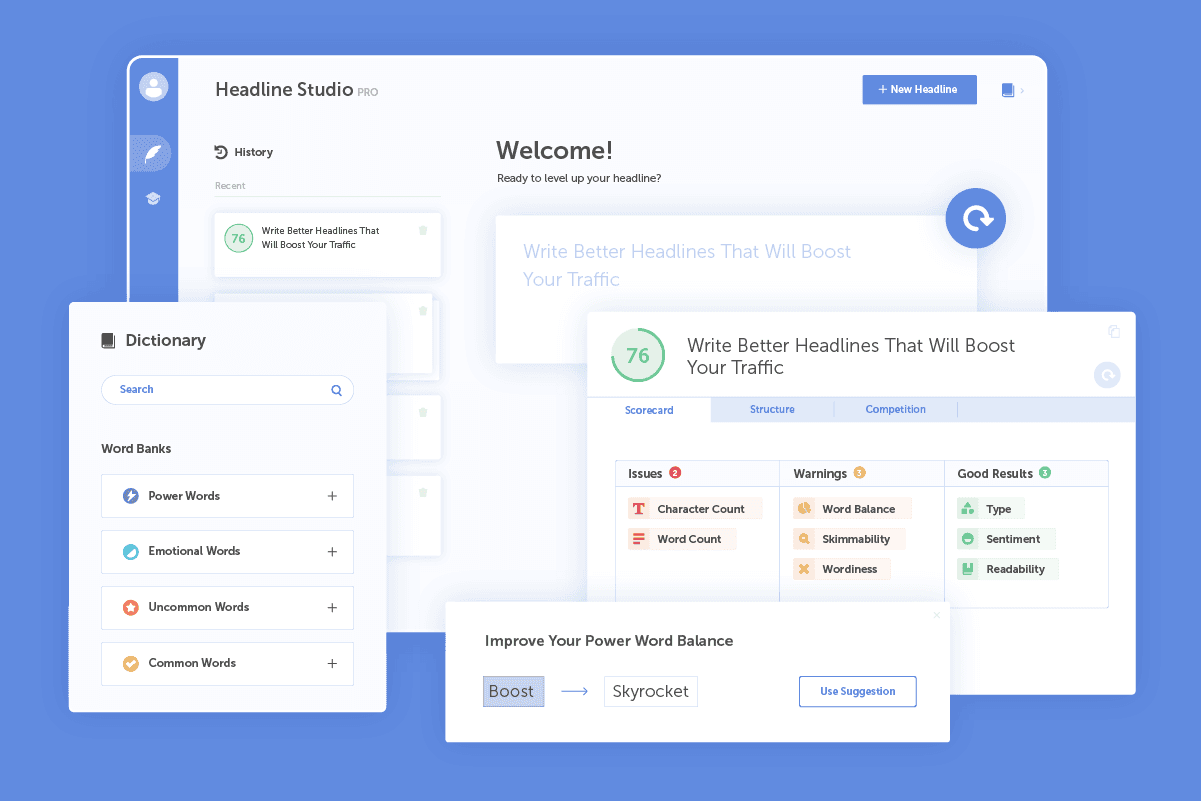
Headline Analyzer Studio is full of features that are proven to improve your headlines, including data-driven lists of strong keywords, word type breakdowns and suggestions for how to score higher and perform better.

Simply type your headline into the tool and use the tips you’ve learned here to write high scoring, high performing headlines!
How to Use What You’ve Learned in a Meaningful Way
You’re a headline maniac now with your five-step process for writing a super catchy blog title. I wanted to recap with a bit of advice you might have seen from us in the past because if you’re serious about improving your blog titles, this is how to take what you just learned to the next level:
- Write your headline first — before writing your post. That will help you focus on the value proposition to keep your writing on track.
- Write at least 25 headlines for every post. Your first take at this might feel awkward, and this process gives you the chance to work through tons of ideas to find the best ones you can use in A/B tests.
- When you put the time into writing great blog titles, use them for multiple purposes. Share alternative versions you came up with in your blog title brainstorm on social media, and A/B test your headlines in your email subject lines. Download Click To Tweet and use alternative headlines throughout your post to encourage more social shares.
- Don’t worry so much about the mechanics. Word count and length — though important in some contexts, like subject lines — don’t matter as much as the catchiness factor you learned about in this post.
- If you decide to write catchy headlines through this process, make sure the content behind the click is just as powerful as your promise.
- Plan time to improve your blog titles by analyzing data from your own audience. This process definitely works for increasing traffic and social shares, but you may have to adjust the pillars according to your own findings.
- Try out Headline Analyzer Studio and get more actionable advice for how to improve each and every headline you write.
You’ve got this. :)

